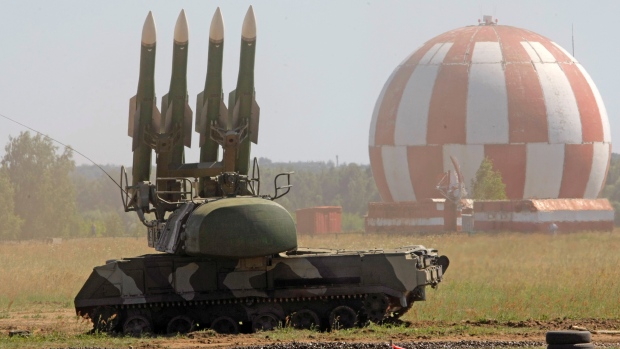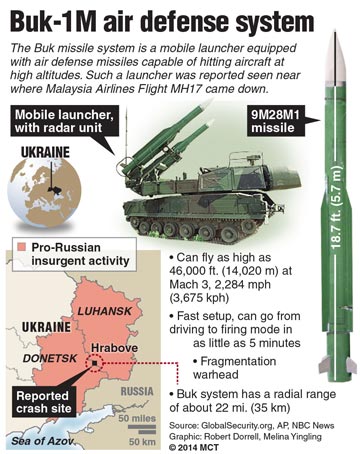Author’s Note: The tragic loss of 298 innocent lives in this incident requires a strong international response that many realize can only be provided by the United States. As SOFREP has recently reported, such a tragic incident involving citizens from nine different nations has now presented the respective governments and people of Flight 17’s victims with over 298 reasons to come to the realization that the Ukraine problem is now an international one. It is our hope that these nations work diligently with the US and its allies in order to achieve an appropriate foreign policy response to this tragedy, one that holds all involved state actors, government and military officials, and Russian-backed separatists duly responsible.
The Buk 9K37 missile system, more commonly known by its Department of Defense/NATO designation SA-11/Gadfly, is the weapon that is believed to have been used by pro-Russian separatists in the shoot-down of Malaysia Airlines Flight 17 in eastern Ukraine on 17 July 2014, as SOFREP has previously reported.
For the purpose of this weapon system profile, the Buk 9K37 will be referred to by its DoD/NATO designation, SA-11. The purpose of this weapon system profile is to provide readers with a brief overview of the system’s capabilities and technical specifications, as well as limited amounts of contextual information regarding the MH017 shoot-down. It must be noted that all of the following information is derived strictly from multiple open-source reports. Although credible, this information may therefore contain figures that vary slightly with previously reported information. The intent is to ensure the most accurate numbers are reported.
Purpose
The SA-11 belongs to a family of self-propelled, medium-range surface-to-air missile systems (SAM) originally developed by the Soviet Union in 1980/1984, and further refined by the Russian Federation. Regardless of any technical improvements that more modern variants of SAMs may provide, the SA-11 remains a highly capable and deadly system.
Capabilities
Designed to engage and defeat a variety of targets, the SA-11 is capable of, but not limited to destroying, “tactical ballistic missiles, air-launched missiles and bombs, antiradar missiles, fixed and rotary wing aircraft, unmanned aerial vehicles, naval ships, and land-based radio-contrast targets, to include: large command posts, tactical ballistic missile control posts, and other facilities.”
Organization
The original SA-11 has been operational since 1980, and has since then gained a reputation as a highly mobile and capable system. When employed as a system by a professionally trained nation state, the SA-11 is typically operated in a battery, and contains the following components: a Command Post (CP), a Target Acquisition Radar (TAR), and six Self-Propelled Mounts (SPMs)/Transporter Erector Launcher and Radar (TELARs). Additional support vehicles such as a specialist Loader-Launcher can also be used. With this battery, a total of six targets “can be engaged simultaneously while they [the targets] are flying on different bearings and at different altitudes and ranges.”
The system can also be placed in a regimental composition, which includes four of the above batteries and a Regimental Target Acquisition Battery. The presence of the Regimental Target Acquisition Battery provides an additional long-range and early-warning search radar capability for the system. In the shoot-down of Malaysian Airlines flight 17, the only system present was the Self-Propelled Mount, or “missile launcher” as mainstream media reports are referring to it.

Execution
Of this system, the essential component that actually initiates a missile launch and prosecutes the target is the Self-Propelled Mount (SPM)/Transporter Erector Launcher and Radar (TELAR). As noted above, while specialist vehicles such as a Loader-Launcher can also be used to conduct a missile launch, the SPM is the vehicle that contains the executive arm of the system.
Essentially a “tracked chassis that carries a radar and a launcher with four missiles,” the SPM is comprised with a suite of digital systems such as a “TV optical sight, a laser range finder, navigation and communications equipment, an IFF interrogator (Identify Friend or Foe), a built-in simulator, and documentation equipment.” With this suite of systems, the SPM is capable of receiving targeting information from a Command Post (CP) vehicle if located in a battery/doctrinal configuration, or independently, if operating outside its typical doctrinal employment (i.e., in irregular/non-professional/non-state actor situations, etc.).
Prosecuting a Target
In a combat situation where the SA-11 is launched independent of the full system/outside its doctrinal use, the SPM “detects its potential target, interrogates it to determine friend or foe (IFF), automatically tracks the target and identifies its type, computes the flight mission and launch assignment, launches a missile, transmits radio correction commands to the missile, and evaluates the firing results.” From the point of target tracking to missile launch, the system’s entire reaction time is around twenty-two seconds.
The Teeth

The original missile launched by the SA-11 is known by its designator 9M38. One missile alone is just over eighteen feet long, weighs 1,521 pounds, and contains a 154.3 pound Fragmentation-High Explosive warhead that detonates based on radar proximity fuse. With a two-stage solid rocket fuel engine and roughly fifteen seconds of burn time, the 9M38 can reach an altitude of 46,000 feet and has a range of nineteen miles. It reaches speeds of over 2,000 miles per hour (almost 3,400 feet per second!), traveling at Mach 3. Using semi-active radar homing, the missile is sent flight path corrections based on proportional navigation computations performed by the SPM while the missile is in flight, allowing it to correctly find its way to its target for a successful intercept.
In Context
Given the above information and the current reporting surrounding the shoot-down of Malaysian Airlines flight 17, the Boeing 777 aircraft and its occupants were likely completely unaware of the fatal circumstances in which they were about to tragically lose their lives. Cruising over eastern Ukraine at approximately 33,000 feet and roughly 570 mph (Mach 0.84), MH017 would have been completely helpless to react to any pending missile launch, regardless of whether or not they knew it what was coming.
Depending on which settings were present to operate the system (i.e. which crews/operators, scan/engagement settings, etc.) and assuming the radars and system were active and ready to launch, the SA-11 would have began the shoot-down by automatically conducting scans within its target acquisition range (out to 62mi from SPM location), detecting its target (within 59mi of SPM location) and interrogating it while computing a flight mission, and automatically assigning a missile to launch. Detecting and tracking the Boeing 777 would have been very easy due to its large radar cross section, which was well within the SA-11’s capabilities. This process likely would have continued until the aircraft reached the engagement range of the missile (about 19mi). Assuming an engagement well within the SA-11’s engagement zone, the missile would have reached the aircraft in roughly ten-twelve seconds, where the radar proximity fuse would have detonated the 154.3 Fragmentation-High Explosive warhead, completely destroying it.

Thanks for listening.











COMMENTS
You must become a subscriber or login to view or post comments on this article.